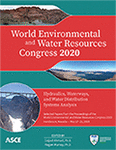World Environmental and Water Resources Congress 2020
Utilization of Stable Water Isotopes and Geochemistry for Detecting Seepage Pathways within North Texas Dam
Publication: World Environmental and Water Resources Congress 2020: Hydraulics, Waterways, and Water Distribution Systems Analysis
ABSTRACT
Identifying geologic and geotechnical related potential failure modes for dam safety risk assessments (backward erosion piping, suffusion, suffosion, etc.) rely on characterizing inherent variabilities and uncertainties within the constructed embankment and geological foundation. Subsurface physical and geochemical reactions from changing hydrologic loads on the dam will affect foundation and/or embankment soil performance over extended periods of time, necessitating dam risk analysis on a regular basis. The geochemical and isotopic compositions of water from groundwater, reservoir, piezometers, spillway, and seepage sites were comprehensively investigated at a North Texas dam. This survey utilized isotopic fractionation processes of deuterium and oxygen-18 to provide quantifiable “fingerprints” of water molecules from each water source. Combined with additional geochemical analysis of the groundwater, where suspected hydraulic pathways were tested against the possible cations/anions contributed by mineral dissolution in the soil, the source and degree of mixing of dam seepage could be approximated. Baseline isotopic signatures were established for groundwater (δD -25.6‰, δ18 O -4.5‰) along with reservoir isotopic ranges (δD -9.10 to -20.00 ‰ and δ18 O -3.37 to -1.00 ‰). By using a binary mixing model, these values were compared to the isotopic signatures from piezometers and suspected seeps to find subsurface hydraulic connections. At the site, a connection between a seep and the reservoir was found. Isotopically, the two samples were located on the same trendline with similar fractionations (seep δD -18.3‰, δ18 O -3.04‰; reservoir δD -20.0‰, δ18 O -3.37‰). Comparing the two samples geochemically a high amount of sulfate contribution (from 31 mg/L to 626 mg/L, a 2,019% increase) lead to the discovery of a potential seepage path through gypsum bearing embankment clay construction fill.
Get full access to this article
View all available purchase options and get full access to this chapter.
REFERENCES
Allen, P. M., Arnold, J. G., & Skipwith, W. (2002). Erodibility of Urban Bedrock and Alluvial Channels, North Texas. Journal of the American Water Resources Association, 1477-1492.
Brock, R., & Hungerford, T. (2015). Statewide freshwater fisheries monitoring and management program survey report, Federal Aid Report F-221. Fort Worth: Texas Parks & Wildlife.
Clark, I., & P. F. (1997). Environmental Isotopes in Hydrologeology. Boca Raton, FL: Lewis.
Craig, H. (1961). Isotopic variations in meteoric waters. Science, 1702-1703.
Dam Safety Technology Development Program. (2005). Report DSO-05-03, Seepage Chemistry Manual. Denver: US Department of the Interior.
Hanna, B. (2019, May 22). https://www.star-telegram.com/news/local/fort-worth/article230657534.html. Retrieved December 10, 2019
Hunt, R. J., Coplen, T. B., Haas, N. L., A. S. D., & Borchardt, M. A. (2005). Investigating surface wtaer-well interaction using stable isotope ratios of water. Journal of Hydrology, 154-172.
Hydroisotop gmbh. (2005). Use of Deuterium and Oxygen-18 as natural environmental isotopes and as artificial tracer. In Laboratorium zur Bestimmung von Isotopen in Umwelt und Hydrologie. Germany: Hydroisotop GMBH.
Mazor, E. (1997). Applied Chemical and Isotopic Groundwater Hydrology. second ed. Marcel Dekker, 413.
McChesney, C. (2017). Stable Isotope Composition of Precipitation from 2015-2016 Central Texas Rainfall Events. College Station: Texas A&M University.
Nielsen-Gammon, J. W., Zhang, F., Odins, A. M., & Myoung, B. (2004). Extreme Rainfall in TExas: Patterns and Predictability. Physical Geography, 340-364.
Spencer, J. (2019, Feburary 12). https://www.kxan.com/weather/weather-blog/new-24-hour-rain-record-for-united-states-confirmed/. Retrieved December 10, 2019
Subhi, Z. (2015). Rainfall Analysis and Trends for the State of TExas in 2015. San Antonio: The University of Texas at San Antonio.
Welker, J. (2000). Isotopic (d18O) characteristics of weekly precipitation collected across the USA: an initial analysis with application to water source studies. Hydrological Processes, 1449-1464.
Information & Authors
Information
Published In
World Environmental and Water Resources Congress 2020: Hydraulics, Waterways, and Water Distribution Systems Analysis
Pages: 264 - 272
Editors: Sajjad Ahmad, Ph.D., and Regan Murray, Ph.D.
ISBN (Online): 978-0-7844-8297-1
Copyright
© 2020 American Society of Civil Engineers.
History
Published online: May 14, 2020
Published in print: May 14, 2020
Authors
Metrics & Citations
Metrics
Citations
Download citation
If you have the appropriate software installed, you can download article citation data to the citation manager of your choice. Simply select your manager software from the list below and click Download.
